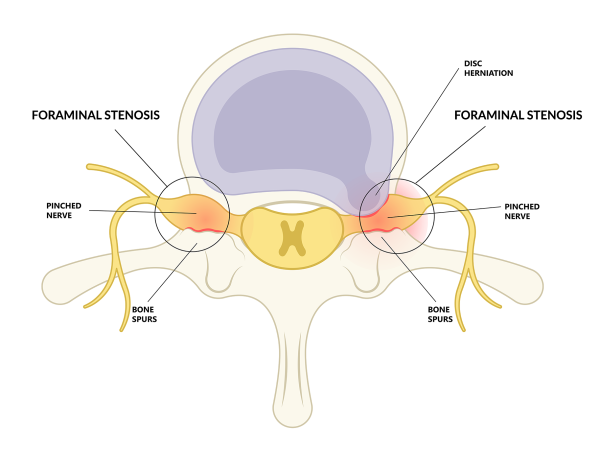Bilateral Foraminal Stenosis
Foraminal stenosis, is a type of spinal stenosis caused by narrowing for the foramina or openings through which the nerves exit the spine. This causes the nerves to be pinched and it usually affects a nerve root on one side of the body. However, in cases of bilateral foraminal stenosis, also known as bilateral foraminal narrowing, both foramina have become narrow and the nerve roots on both the right and left sides of the spine are pinched. The symptoms therefore affect both sides of the body, per example when the stenosis is in the lumbar spine pain can radiate down both legs along the nerve pathways.
Although the foramina can become narrow at any level of the spine, it is more common in the seven cervical vertebrae that make up the neck or the five vertebrae that make up the lumbar spine. Foraminal narrowing is unusual in the thoracic vertebrae (mid back) due to its limited mobility. In addition, although the compression caused by narrowing on one side is more common, narrowing and compression on both sides can occur in the cervical or lumbar spine.
Causes of Bilateral Foraminal Stenosis
Bilateral foraminal stenosis is usually caused by a degenerative condition of the spine. When the bones of the spinal column wear down through normal wear and tear, they cause spinal pressure on the foraminal canals and limit the space in the spinal canal through which the nerve roots travel.
Causes of bilateral foraminal narrowing may include:
- Bulging disc
- Bone spurs
- Slipped disc
- Age-related disc degeneration
- Rheumatoid arthritis
- Osteoporosis
- Spondylolisthesis
Symptoms of Bilateral Foraminal Stenosis
As the foramina narrow, they start to put stress on the spinal nerves, causing symptoms at the level of nerve root compression. The symptoms may include:
- Pinched nerves
- Pain that radiates down to the arms or legs
- Pain that develops over the course of time (often years)
- Muscle weakness, tingling, and numbness
- Feeling pins and needles on the extremities
- Burning pain in the extremities
- Headaches and brain fog (cervical)
Diagnosing Bilateral Foraminal Stenosis
If the pain lasts more than a week or two, patients should schedule an appointment with their doctor to find out what is causing their symptoms. Your doctor will review your medical history, ask questions to determine the severity of your symptoms, and perform a physical and neurological assessment of your condition. He/she may also require studies such as x-rays, MRIs, or CT scans.
Treatment for Bilateral Foraminal Stenosis
If you have symptoms caused by narrowing of the foramina on both sides, your doctor will discuss with you the treatment options available. Often patients can manage mild symptoms with conservative, non-surgical options. However, if the symptoms continue after three months or the pain becomes unbearable then surgery may be necessary.
Non-Surgical Treatment
Your doctor may recommend a combination of two or more of the following conservative, non-surgical treatment methods to alleviate your symptoms:
- Rest
- Physical therapy
- Pain medication
- Weight Loss
- Low-impact exercises and stretching
- Chiropractic care
- Corticosteroid injections
Surgery for Bilateral Foraminal Stenosis
The Bonati Spine Procedures relieve the pain caused by foraminal stenosis and return the patient to normal activities within days. They are done in an outpatient basis instead of a hospital. And performed under local anesthesia and conscious IV Sedation which avoids the risks of general anesthesia. The patient walks out of the surgery room within an hour of the procedure once the pain has been alleviated. And is able to return to normal daily activities within days of the procedure.
We have helped thousands of people who suffered from this condition, watch a patient testimonial for Foraminal Spinal Stenosis

